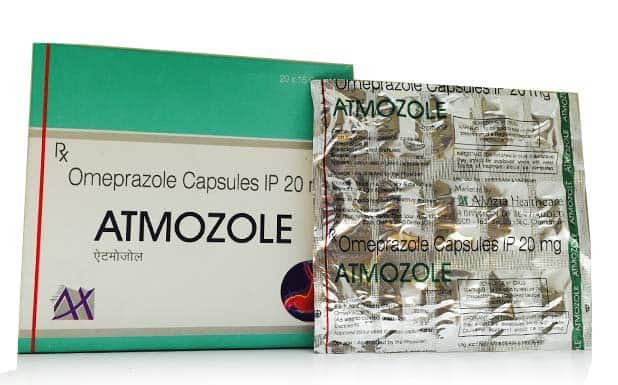
Composition
- Each Capsule Contains:
- Omeprazole Magnesium IP
20 mg
Packing
- 20x15
(Alu-Strip)
MRP
- 40.95
Overview
Omeprazole belongs to group of drugs called proton pump inhibitors. It decreases the amount of acid produced in the stomach.
Omeprazole is used to treat symptoms of gastroesophageal reflux disease (GERD) and other conditions caused by excess stomach acid. It is not for immediate relief of heartburn symptoms.
Omeprazole is also used to promote healing of erosive esophagitis (damage to your esophagus caused by stomach acid). Omeprazole may also be given together with antibiotics to treat gastric ulcer caused by infection with helicobacter pylori (H. pylori).
Warnings
Some medical conditions may interact with omeprazole magnesium delayed-release capsules and tablets. Tell your doctor or pharmacist if you have any medical conditions, especially if any of the following apply to you:
if you are pregnant, planning to become pregnant, or are breast-feeding
f you are taking any prescription or nonprescription medicine, herbal preparation, or dietary supplement
if you have allergies to medicines, foods, or other substances
if you have low blood potassium or magnesium levels, low blood vitamin B12 levels or vitamin B12 deficiency, liver problems, or stomach or bowel cancer
if you have nausea or vomiting; stomach pain; heartburn with light-headedness, sweating, or dizziness; chest or shoulder pain with shortness of breath; unusual sweating; pain spreading to the arms, neck, or shoulders; or light-headedness
if you have unexplained weight loss; frequent chest pain; or frequent wheezing, especially along with heartburn
if you have had heartburn for more than 3 months
if you have osteoporosis (weak bones), a family history of osteoporosis, or other risk factors of osteoporosis (eg, smoking, poor nutrition)
Contraindications
Omeprazole Capsules are contraindicated in patients with known hypersensitivity to substituted benzimidazoles or to any component of the formulation. Hypersensitivity reactions may include anaphylaxis, anaphylactic shock, angioedema, bronchospasm, interstitial nephritis, and urticaria.
Side Effects
All medicines may cause side effects, but many people have no, or minor, side effects. Check with your doctor if any of these most COMMON side effects persist or become bothersome:
Diarrhea; gas; headache; nausea; stomach pain; vomiting.
Dosage
Oral:
Disclaimer:To be taken only after consulting with the doctor.
Pharmacology
Mechanism of Action
Omeprazole belongs to a class of antisecretory compounds, the substituted benzimidazoles, that suppress gastric acid secretion by specific inhibition of the H+/K+ ATPase enzyme system at the secretory surface of the gastric parietal cell. Because this enzyme system is regarded as the acid (proton) pump within the gastric mucosa, omeprazole has been characterized as a gastric acid-pump inhibitor, in that it blocks the final step of acid production. This effect is dose-related and leads to inhibition of both basal and stimulated acid secretion irrespective of the stimulus. Animal studies indicate that after rapid disappearance from plasma, omeprazole can be found within the gastric mucosa for a day or more.
Pharmacokinetics
Absorption: Omeprazole Capsules contain an enteric-coated granule formulation of omeprazole (because omeprazole is acid-labile), so that absorption of omeprazole begins only after the granules leave the stomach. Absorption is rapid, with peak plasma levels of omeprazole occurring within 0.5 to 3.5 hours. Peak plasma concentrations of omeprazole and AUC are approximately proportional to doses up to , but because of a saturable first-pass effect, a greater than linear response in peak plasma concentration and AUC occurs with doses greater than . Absolute bioavailability (compared with intravenous administration) is about 30-40% at doses of 20-, due in large part to presystemic metabolism. In healthy subjects the plasma half-life is 0.5 to 1 hour, and the total body clearance is 500-600 mL/min.
Based on a relative bioavailability study, the AUC and Cmax of Omeprazole (omeprazole magnesium) for Oral Suspension were 87% and 88% of those for Omeprazole Capsules, respectively.
The bioavailability of omeprazole increases slightly upon repeated administration of Omeprazole Capsules.
Omeprazole Capsule was bioequivalent when administered with and without applesauce. However, Omeprazole Capsule 20 mg was not bioequivalent when administered with and without applesauce. When administered with applesauce, a mean 25% reduction in Cmax was observed without a significant change in AUC for Omeprazole Capsule 20 mg. The clinical relevance of this finding is unknown.
Distribution: Protein binding is approximately 95%.
Metabolism: Omeprazole is extensively metabolized by the cytochrome P450 (CYP) enzyme system.
Excretion: Following single dose oral administration of a buffered solution of omeprazole, little if any unchanged drug was excreted in urine. The majority of the dose (about 77%) was eliminated in urine as at least six metabolites. Two were identified as hydroxyomeprazole and the corresponding carboxylic acid. The remainder of the dose was recoverable in feces. This implies a significant biliary excretion of the metabolites of omeprazole. Three metabolites have been identified in plasma the sulfide and sulfone derivatives of omeprazole, and hydroxyomeprazole. These metabolites have very little or no antisecretory activity.